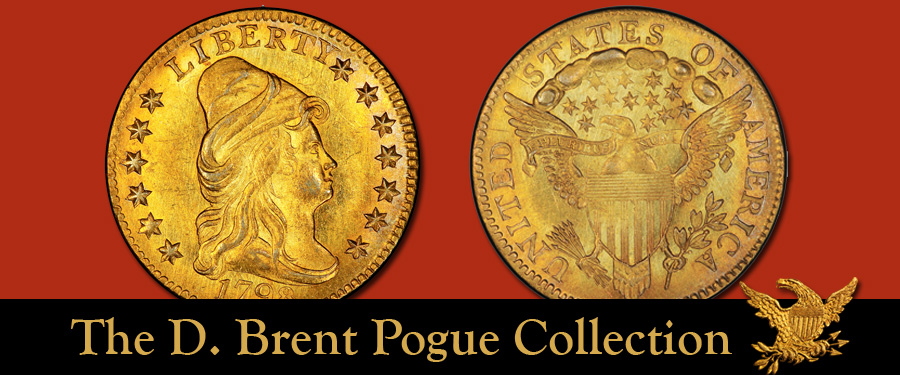
Quarter Eagles of 1798
The 1798 quarter eagle is one of a string of $2.50 gold coins with Miss Liberty wearing a conical cap (“Capped Bust to Right” the Guide Book calls it) in combination with the Heraldic Eagle reverse. This general type was made from 1796 to 1807. Each of the varieties is rare, and some are very rare. Another aspect is condition rarity, in which a rare coin can be exceedingly so if in a high grade, as here.
Two pairs of dies were used in 1798. The coin showcased is the variety known today as Bass Dannreuther-1 with Close Date on the obverse and four berries on the reverse, the rarer of the two pairs. On the obverse the stars are arranged six left and seven right. In calendar year 1798 there were 614 quarter eagles struck. It was Mint policy at the time to keep dies in use as long as they were serviceable. Accordingly, this small mintage figure might include some dated earlier, such as 1797. In December 1799 there was a delivery of 480 coins. As no 1799-dated quarter eagles are known, it is presumed that these were dated 1798.
Description of the obverse die:
Obverse die for BD-1: Low Close Date. • Stars 6 left and 7 right (on both dies of this year. 1798 was the only year of the 1796 to 1807 type for which the 6×7 configuration was used. • Details: 1 (1798) is close to the hair; 98 separated from the drapery; 8 too small (true of both 1798 dies). LIBER (LIBERTY) widely spaced; TY very close; Y close to star 7. Star pairs 7-8, 8-9, and 12-13 are more widely spaced than are any of the others.
On both dies the final digit, 8, of the 1798 date is a tiny numeral compared to the 179. This situation, which occurs among several late 18th century and early 19th century American issues of various denominations, was caused by the practice of preparing the dies in advance with the first three digits of the date. Then, at the actual time of use the remaining digit was punched in. It was easy at that time to use a wrong-sized punch. The Melish Collection specimen (Abe Kosoff, 1956) had a large “cud” break on the obverse rim encompassing most of the 1 (1798), stars 1-3, and part of star 4, and must be among the final impressions from this obverse die.
There were two reverse dies used as well. Description of the one showcased here:
1798 reverse die for BD-1: Four berries in branch. Only 13-star reverse die of the Type II quarter eagle with no star near U (PLURIBUS) and with no star close to rightmost cloud. • Details: D (UNITED) far from wing. O (OF) over right part of cloud. Left foot of 1st A (AMERICA) rests on feather; bases of AMERI close or touch; leaf does not touch I. Lowest outside left arrowhead tip is below left upright of N (UNITED).
The Pogue Collection Coin
Quite a few years ago I (QDB) commenced building a database on United States coins. Since then I have kept it up with occasional additions. I estimate that about 50 to 70 examples of the 1798 quarter exist today, with perhaps five to seven in Mint State. Of the last I have only ever learned of one Gem—the coin that is today a part of the D. Brent Pogue Collection.
This coin was part of the remarkable type set of United States coins formed by Norman Stack, a partner in the firm that still bears his name. Norman’s emphasis was on ultra-quality. Over a period of years he assembled a display that has had little competition before or since.
At a later time, in June 2000, his coin was cataloged by David E. Tripp for Sotheby’s:
Lot 359: 1798, Brilliant Uncirculated. Obverse with two small mint caused dots before face of Liberty, and faint obverse and reverse adjustment marks. The fields are prooflike and with ample die polish lines, an astonishing specimen. Obverse with closely spaced date, with small 8 not touching drapery, the reverse with four berries, thirteen large stars, and ED ST excessively weak. An interesting date with a unique obverse star configuration of 6 by 7 stars. The finest known example of this date, housed in a PCGS holder as MS-65, and of the highest rarity and importance. Published, United States Type Coins, Norman Stack, 1977 and 1986, p. 54, this piece. Ex Norman Stack Collection. This coin is widely acknowledged as the finest known specimen for this date. Akers noted in his standard reference that “By far, the finest 1798 quarter eagle that I have seen was a gem owned a few years ago by Stack’s.”
When this coin crosses the auction block in May, the buyer will have a coin with no equal!





